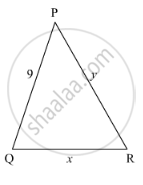Advertisements
Advertisements
प्रश्न
The diagonals of quadrilateral ABCD intersect at O. Prove that
`[A(∆"ACB")]/[A(∆"ACD")] = "BO"/"DO"`
उत्तर
We are given the following quadrilateral with O as the intersection point of diagonals

To Prove : `[A(∆"ACB")]/[A(∆"ACD")] = "BO"/"DO"`
Given ACB and ACD are two triangles on the same base AC
Consider h as the distance between two parallel sides
Now we see that the height of these two triangles ACB and ACD are same and are equal to h
So
`[A(∆"ACB")]/[A(∆"ACD")] = (1/2 xx "AB" xx "h" )/(1/2 xx "CD" xx "h")`
`=("AB")/("CD")`..........(2)
Now consider the triangles AOB and COD in which
`∠ "AOB" = ∠ "COD"`
`∠ "ABO" = ∠ "ODC"` (alternative angle)
`∠ "BAO" = ∠ "DCA"` (alternative angle)
Therefore , `Δ "ODC" ∼ Δ "OBA"`
`⇒("AO")/("OC") = ("BO")/("DO")=("AB")/("CD")`
`⇒ ("BO")/("DO") = ("AB")/("CD")`
From equation (1) and (2) we get
`[A(∆"ACB")]/[A(∆"ACD")] = "BO"/"DO"`
Hence prove that `[A(∆"ACB")]/[A(∆"ACD")] = "BO"/"DO"`
APPEARS IN
संबंधित प्रश्न
Diagonals AC and BD of a trapezium ABCD with AB || DC intersect each other at the point O. Using similarity criterion for two triangles, show that `"OA"/"OC"="OB"/"OD"`.
In the given figure, given that ∆ABC ∼ ∆PQR and quad ABCD ∼ quad PQRS. Determine the value of x, y, z in each case.

The area of two similar triangles are 36 cm2 and 100 cm2. If the length of a side of the smaller triangle in 3 cm, find the length of the corresponding side of the larger triangle.
In ∆ABC, ray AD bisects ∠A and intersects BC in D. If BC = a, AC = b and AC = c, prove that \[BD = \frac{ac}{b + c}\]
In the figure given below DE || BC. If AD = 2.4 cm, DB = 3.6 cm, AC = 5 cm. Find AE.
The areas of two similar triangles are 169 cm2 and 121 cm2 respectively. If the longest side of the larger triangle is 26 cm, what is the length of the longest side of the smaller triangle?
In a ∆ABC, ∠A = 90°, AB = 5 cm and AC = 12 cm. If AD ⊥ BC, then AD =
The length of the hypotenuse of an isosceles right triangle whose one side is\[4\sqrt{2} cm\]
If ∆ABC ∼ ∆DEF such that AB = 9.1 cm and DE = 6.5 cm. If the perimeter of ∆DEF is 25 cm, then the perimeter of ∆ABC is
In an isosceles triangle ABC if AC = BC and AB2 = 2AC2, then ∠C =
